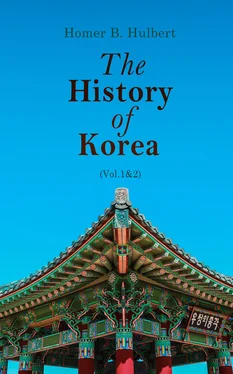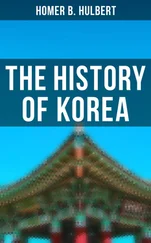In 68 Păk-je deemed herself strong enough to undertake operations against Sil-la. She began by seizing the fortress of Wa-san. She enjoyed possession of it for nine years but in the end she paid dear, for it was retaken by Sil-la and the Păk-je garrison was put to the sword. This year also saw a continuation of Ko-gu-ryŭ’s forward policy and the little settlement of Kal-sa which had been make by Pu-yŭ fugitives was absorbed. She followed this up by the conquest of Chu-ra farther north. Her military strength seems to have been on the rapid increase.
In 80 the great Sŭk-t’al-hă died and was succeeded by the son of King Nam-hă. He must have been of advanced age and yet not so old as to prevent his becoming the greatest conqueror that Sil-la ever produced. During the thirty-two years of his reign he added to the Sil-la crown the districts of Eum-jip-pŭl, Ap-to, Pi-ji, Ta-bŭl, Ch’o-p’al, and Sil-jik. These together with U-si and Kŭ-ch’il, which and been added the year before his accession, formed a considerable increase in the territory of the kingdom and added not a little to Sil-la’s reputation as a military power. This king, P’a-sa, was one of those men who seem to take hold of affairs by the right end and wring success from seeming failure. He was as great an administrator as he was mild a conqueror. He attended so carefully to the needs of the people that it is said that during most of his reign food was so plentiful that the wayfarer needed no money to pay for food or lodgings along the road.
The kingdom of Ka-ya, whose origin we noted in the previous chapter, now assumed the offensive against Sil-la. The first intimation we have of this is the fact that Sil-la in 88 built two forts named Ka-so and Ma-du, the first of which was to guard against the encroachments of Păk-je and the second to guard against those of Ka-ya. It was not till three years later that Ka-ya actually opened hostilities by inaugurating an expedition against Sil-la. As the event is not disclosed by the annalists we may conclude that it was unsuccessful.
Ko-gu-ryŭ now extended the field of her military operations. She made friends with the people of Ye-măk, to the east, and together with them began a series of raids into Chinese territory beyond the northern borders. The sixth king of Ko-gu-ryŭ, T’ă-jo Wang, had now reached the sixty-ninth year of his reign so he turned over to his brother, Su-sŭng, the administration of affairs. This brother was as ambitious as the king and continued the league with Ye-măk and the encroachments upon China. But he was disloyal to his brother and tried to form a combination against him. In this he was not successful. The reign of this T’ă-jo Wang was the longest one on record in Korean annals. He held the scepter ninety-four years, thereby sorely trying the patience of his heir apparent. That gentleman came to the throne at the green old age of seventy-six, in the year 147 A.D. He showed however that his memory had not yet failed him for one of his first acts was to arrestto arrest and put to death all the wise men who had chidden him for attempting to unseat his brother. Ko Pok-chang a celebrated scholar of that day was so overwhelmed in view of this barbarous act that he asked to be destroyed with the rest of the wise men, a wish that was probably granted. One day this singular monarch having seen a white fox cross his path, an evil omen, asked a soothsayer what it might portend. That individual suggested that if the king should reform even the worst of omens would turn out happily. The soothsayer lost his head as a result of his candor; but from that day on, whenever the king wanted to consult a soothsayer he found that they were all engaged in important work at some distant point.
King Il-seung of Sil-la whose reign began 134 was the first to pay attention to the building of good roads throughout the country. In his fifth year he built a road from his capital to Chuk-yŭn, now Pung-geui, and another one over Kye-ip Pass. These became very important thoroughfares. We also find that his successor continued this good work by opening roads throthro to the north of the kingdom. These kings were not many years behind the Romans in recognising the vast importance of good roads both for administrative and military purposes.
The relations between Sil-la and Japan are graphically described in the single statement that when someone circulated in the capital the rumor that a company of Japanese were coming the people fled precipitately from the city until it was half depopulated. When the mistake was discovered they gradually came back.
The interesting legend of Yŭng-o and Se-o belongs to the year 158, though it scarcely merits the “once upon a time” of a nursery tale. Yŭng-o a poor fisherman lived with his wife Se-o beside the waters of the Japan Sea on the eastern shore of Sil-la. One day as Yŭng-o was seated on a great boulder beside the water, fishing, he felt the rock tremble and then rise straight in air. He was carried, to his great consternation, eastward across the sea and deposited in a Japanese village. The Japanese folk took him for a god and made him their king at once. When his wife found that he did not return from fishing she went in search of him. Ascending the same rock that had carried him to Japan she experienced the same novel extradition that had so surprised her spouse. She found him metamorphosed into a king and was nothing loath to become queen. But their departure brought disaster to Sil-la for the sun and moon were darkened and the land was shrouded in gloom. The sooth-sayers said it was because someone had gone to Japan. An envoy was sent post haste to those islands in search of the fugitives, but found to his dismay that they had become king and queen of one of the kingdoms there. He told his story and besought them to return, but they seemed well satisfied with the change. Se-o however brought out a roll of silk and gave it to the envoy saying that if the king of Sil-la would spread it out and sacrifice upon it the light would return. The event proved the truth of her statement and when the king uttered the words of invocation the sunlight burst forth again and all was well. It is an interesting but melancholy fact that most of the arguments used to show a Korean origin of things Japanese are based upon evidence nearly if not quite as credible as this story. The Japanese work entitled the Kojiki bears the same relation to the carefully detailed history of Sil-la that the Niebelungenlied bears to the works of Tacitus.
When the time came for Su-sŭng, the sanguinary king of Ko-gu-ryŭ to die a young scapegrace by the name of Ch’a-da came to the throne. His idea of royalty was that it consisted in one long orgie. He attempted to carry out his ideal but was cut short within a year by the assassin’s knife. His motto, in his own words, was “Who does not wish to enjoy life?” Epicureanism may have existed in Korea before but it had never had so frank a disciple. Păk-ko a relative of the murdered king was called from a mountain fastness whither he had fled for safety. They had to ask him three times before they could convince him that it was not a mere decoy.
By the year 168 either Păk-je had grown so strong or Sil-la so weak that the former deemed it a fit time to make a grand demonstration all along Sil-la’s western border. It is said she carried back a thousand captives to grace her triumph. Sil-la, though filled with rage, was not in condition to return the compliment in kind. She however sent an urgent letter pointing out the advantages of peace and asking that the captives be returned. We may imagine how this was received by the proud army flushed as it must have been by an unwonted victory.
About this time was begun one of the ancient customs of Korea that has ever since exerted an important influence upon the life of the people. While hunting the king met a man weeping bitterly and upon being asked what was the matter replied that he had not a grain of food to give his parents. Thereupon the king gave him an order on the government granary with the understanding that when autumn came he should pay it back. Thus originated the whan-sang or custom of making government loans in the spring to be paid back with interest in the autumn. When this king died he was succeeded by the grandson of old Sŭk-t’al-hă. He took in hand the work of instilling new life into the well-nigh dead bones of Sil-la. His first action was to establish two military stations at the capital so that it might not be at the mercy of the first adventurer that might pass that way. He also ordered the people to pay less attention to the construction of fine government buildings and more to agriculture, the back bone of the state.
Читать дальше












